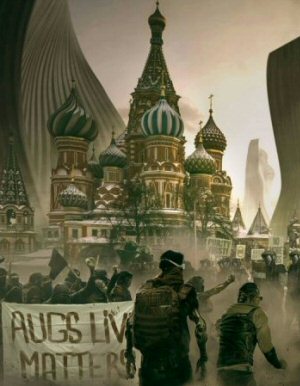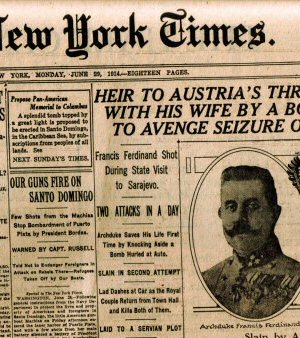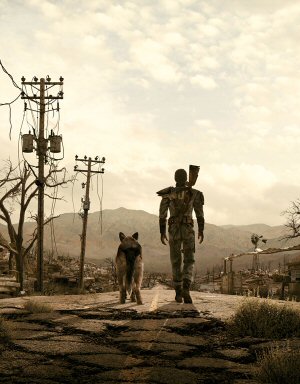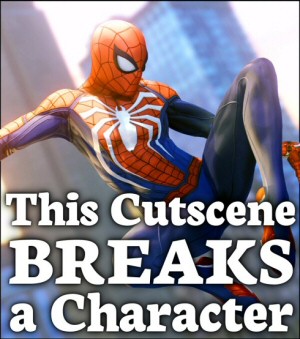
Don’t forget to make your super-monsters immune to your super-weapons, or you’re just shooting yourself in the foot.
Shamus Says:
Thanks to readers who are better at the internet than I am, we have the rest of the comic, the original commentary, the comic titles, and the original ending.
Thanks to Eric and Damien for the help.
Shawn Says:
This is one of the few CB strips that really falls flat for me. Partly because I thought the “Players Kill Plot Important Bad Guy Instantly” was done better both times it came up in DMotR, and partly because it’s a joke that didn’t really need to be repeated a 3rd time, and partly because Casey really should have learned by now, and given the giant skeleton guy a suit of armor of Immunity to Spears or something.
Ah well.
Also, I’ve never be able to see General Femur’s face as intended. He’s supposed to have empty eye sockets, but the bone ridge make me think he’s just closing his eyes and grinning, anime-style.
Deus Ex and The Treachery of Labels

Deus Ex Mankind Divided was a clumsy, tone-deaf allegory that thought it was clever, and it managed to annoy people of all political stripes.
Internet News is All Wrong

Why is internet news so bad, why do people prefer celebrity fluff, and how could it be made better?
Blistering Stupidity of Fallout 3

Yeah, this game is a classic. But the story is idiotic, incoherent, thematically confused, and patronizing.
This Scene Breaks a Character

Small changes to the animations can have a huge impact on how the audience interprets a scene.
Skylines of the Future

Cities: Skylines is bound to have a sequel sooner or later. Where can this series go next, and what changes would I like to see?
 T w e n t y S i d e d
T w e n t y S i d e d

Ah, yes, having some fun memories resurfacing of finding out just how silly Heal + undead where in Bauldurs Gate, and games of a similar era…
Nothing says ‘boss battle’ like turning the elder evil into dust with a single ‘Kicketh Thy Wereth Ith Hurtheth’ spell.
Bit of a shame so few games nowadays let you do stuff like that. There’s still exceptions, of course, like how Shadowrun: Hong Kong let you trick it’s final boss into striking a bargain she can’t actually uphold, but it’s very rare that you’re allowed to feel clever like that.
I remember in the old final fantasy games there were a couple of Undead boss fights – insta-killed by using a Phoenix Down on them. And for the others there was the ‘make them vulnerable to magic with a support spell, then cast Death’ tactic…
And yeah, Casey really should have learned by now. Ideally it should never have happened in the first place.
Let’s hope Deuse Bajj isn’t an Undead as well…
Still works in FF X (or is that one considered an old one?).
You *could* use a Phoenix Down…or you could suplex a train. I mean, there’s really only one right choice here.
And that’s not just suplexing a train…
…that’s suplexing a speeding train by picking up the engine at the front – all whilst running backwards along the tracks in front of it.
(Incidentally, this is a talking train that takes dead souls to the Underworld. You’re basically punching it the face because you’re not ready to die and it refuses to stop early to let you off.
…only in a JRPG.)
Suplex a train and THEN hit it with a Phoenix Down for maximum hilarity.
My favorite train suplex is this one from a glitched playthrough: https://lparchive.org/Breaking-Final-Fantasy-VI/Update%2006/
In FF Tactics, if you used skeletons or ghosts in your lineup, the AI would do this to you.
Best thing about the Shadowrun: HK example is that it’s a reward for interacting with the NPCs/other characters. You put the time in to roleplay and you can use the knowledge you’ve gained to do…quite a few things.
Dragonfall kind of let you do it too, though you still got the fight at the end.
SR: HK is the only final boss dialogue puzzle I’ve ever played that surpasses the original Fallout for me, and for this exact reason.
Fallout had it to a lesser extent; you don’t ruin the Master’s plan by having 100 Speech and thinking up something in 2 seconds, but by venturing into The Glow and collaborating with the then-isolationist Brotherhood of Steel.
It’s for this reason precisely that Shadowrun HK and Dragonfall are actually among some of my favorite modern retro-styled cRPGs, rating pretty far above Wasteland 2 and Pillars of Eternity. Shadowrun really goes all in when it comes to making dialogue a really big part of the game in a way that we haven’t really seen since Fallout 1 and 2.
Planescape: Torment has like 10 different ways to avoid the final boss fight, with several stat check options, some items you could have gotten earlier, some things you could have found out, or you can trick it and get your party back for the fight. There are very, very few enemies that you actually have to fight in that game.
Planescape: Torment is pretty much the gold standard for dialogue mattering in games, though.
Just such a tiny thing as there being street vendors, and what you’re buying basically being a text-box worth of—pardon the pun—flavor text…
Damn rare game that thinks about stuff like that for world-building.
Planescape: Torment is also up there, and this comment got me thinking that I may not have appreciated it fully because of the way the rest of the game played out:
(1) At some point I couldn’t figure out what I needed to do to proceed so I did, like, every optional thing so I didn’t get a good perspective of what was necessary and what was sidequesting
(2) I hate Infinity Engine combat and the final dungeon is full of it
(3) Because of (1), it’s entirely possible I couldn’t tell the difference between “cool thing you can do because you learned about it” and “cool thing you can do because of your stats and the main quest”. It felt like the dialog options weren’t using anything that didn’t come from the mandatory interactions with, say, Ravel Puzzlewell, but I could be wrong about that.
I’ve heard some snide remarks about dialogue in the style of: [25 STR] [You flex so hard, that Gluts, The God of Beefcake, bows trembling before you!], and so on, but I think not having that sort of stuff is one of the few things in P. T that was flawed design from day one.
Sure, the text can get a bit goofy with all those [Stats], [Feats] and [Skill] tags all over the place, but it lets the player actually know when & how how they built their character actually matters in a clear & concise way.
P: T on the other hand… again, great game, but only way to know what your stats actually does is either reading a guide, or replaying the game and noticing the differences, and I definitely remember being more then a bit frustrated my first time through over that.
My problem with listing the requirements in the dialog tree is when there are greyed out options that tell me how cool I’m not. I always feel like I’m missing out as a result, because there aren’t enough stat points to go around.
PoE did an even stranger thing where they made all of the stats do the same thing for everyone. Might increased damage for everyone, even spellcasters, and intelligence increased the area of all AoE effects, even barbarians’.
I do like the core concept that there was no double-dipping (like in D&D where Strength is by default both the melee accuracy and melee damage attribute), but I think it would have worked better if e.g precision attacks used Dexterity for accuracy and Intelligence for damage, but brute force attacks used Dexterity for accuracy and Strength for damage. One of the emergent properties I predict from implementing that is a multiclass character that has a stat distribution such that they can make powerful attacks at modest accuracy, accurate attacks at modest power, or balanced attacks, by having access to three different types of attack that all use different stats, and picking the one that best matches the opponent. 4e /kinda/ did that by having 4 defenses to target, but 4e went the opposite way on double-dipping and gave every class an ability score that they were best off maximizing.
Can see what you mean, yeah. A lot of RPGs ride high on power-fantasy, so telling you even indirectly like that that your character has blind spots can break that illusion.
Did like how Fallout: New Vegas handled it, where the ‘skill too low’ is an entirely different and often hilarious line of dialogue that makes you look an idiot. Got some really good laughs from that, but I’ll freely admit it’s a TON of more work doing it that way.
I prefer games showing you the stats for options you qualify to take and not showing the options you don’t have the checks for. FTL has blue dialogue for having certain systems or crew that tells you why you have that option, but if you don’t have it you don’t see it.
Negative/Positive Energy spells still work basically the same way in current D&D (and Pathfinder) editions. Healing spells are Positive Energy, so they damage undead. Negative Energy spells (like Inflict XYZ Wounds) conversely heal undead and damage mortals.
Think this is mostly removed—or haven’t been standardized yet at least—in D&D 5th edition as part of its streamlining, actually.
There’s a few hold-outs, like Xenathar’s Guide’s Negative Energy Flood, but even that one only gives Undead creatures temporary hit-points, not actual healing. Most of the rest of the healing & harm spells just do that now, no matter what type of creature you use them on.
Can admit I see the logic, but I still miss the world-building and internal logic of Positive/Negative Energy.
The basic interaction works, but Heal at the time restored all but 1d4 of your HP, or reduced undead to 1d4 HP.
Later editions of D&D changed Heal/Harm to just be a large amount of HP, rather than an uncapped amount.
One of my favorite tabletop moments features a gigantic gorilla-like creature who happens to be a lich. The monster has cast a silence spell on itself. Our spellcasters retreat out of the area of effect so they can, y’know, participate in the battle.
My character is the only one who can identify the thing’s undead nature, but he’s still in the zone of silence as I hear our cleric say, “I CAST HARM!” and run in to deliver a ton of . . . healing.
I don’t think there’s any harm in a running gag. That said, the execution was missing something for me here. Maybe because its the first strip of this series I’ve read and I’m missing some set up from previous strips. I do agree that DM of the Rings executed better than this. Or at least I felt like it at the time.
I think part of it is that the instant stab kill comes a little too soon in the comic. Maybe if the villain had had longer to speak and it looked like what he had to say was plot important (and possibly also humorous so that it seems like at first the joke is going to be about stuff that he says) then you can subvert our expectations by having your guy stab and insta-kill the seemingly plot important NPC who was getting a big build up in the middle of his now long winded speech (or dialog with the PCs where they snark at him).
But then I don’t laugh easily these days. I think its something I’m taking that’s effecting that so I might not be the best person to ask. Maybe everybody else thought it was funny.
One of the Spiderman video games had a boss who made a big dramatic show of entering and having five layered health bars fill up, only to get KO’d with a single punch. This one sort of fell flat on the expectations side, might’ve been neat with a big lead-up of rolling initiative and setting up a battle map with the munchkin salivating at the chance to take his turn, only to end it in one poke. That’d take a lot of panels though, telling concise jokes is hard.
I went the other way around in my game, where the instant kill switch was absolutely necessary to take down the final boss, whose fight was more a matter of trying to taunt it into entering range when it could basically ignore anything the party did unless it tied into its win condition. (That was a very railroad-y game, though hopefully on the “rollercoaster” side of that spectrum.)
Yeah, it’s basically the comic version of the Indiana Jones gag where the big bruiser comes up, swirls his sword elaborately and menacingly, and Jones shoots him and stalks off. Beat. Only the pacing here is that the scene starts with the gunshot, and tapers off into the director arguing with Ford about whether Indy would have any bullets left at this point – loses a bit of punch. I think it recovers a bit with the library book joke, actually; not terrible overall, just oddly timed.
>>Thanks to Eric and Damien for the help.
Damien Lucifer? Did we ever find out what happened with him? He just kind of disappeared.
I think part of the problem with this one (for me at least) is that the picking on Casey comes across as more mean-spirited as the comic goes on. I may just be a fuddy-duddy, but while it’s one thing to be deliberately annoying, it’s another to be deliberately mean, and the latter is just not funny to me.
I’d argue that Casey’s walked right into a lot of this, and done his own fair share of picking on. But that just makes the comic “assholes being assholes to each other”, which I’m also not a huge fan of.
This is true. I wonder why it was funnier in DMotR. Maybe because we didn’t see the players’ faces, so it seemed more like Aragorn et al. were breaking the fourth wall and less like there were real* people being jerks to each other on purpose.
*for certain values of “real”
Oh, my reply down below should have gone to this one. The players are messing with the DM in DMotR because they’re very frustrated with him running his story all railroaded and treating them as glorified extras.
The players are messing with the DM in Chainmail Bikini because they’re dicks.
No one knows what happened to Damien. Apparently, folks who know some other sites where he hung out say he’s disappeared there, too.
I say he’s locked up for selling Krokodil out of his trunk, but it’s always possible he finally joined the monastery and he’s milling barley.
To be out of touch this long with his last messages giving no sign of any change. I just don’t know. But then I’ll bet you all had questions about what happened to me and I’m back.
By the way, what happened in my case was that I couldn’t access the blog where I normally access it but now I can again.
I got a friend that I think is in the Ukrainian mob, maybe he’ll have connections to check up on that Krokodil selling.
That’s easy. In DMotR, the players were the victims of the railroading DM, and their snarking is their way of maintaining their sanity, and about the only way they had any input in the story. The readers are left wondering why the players are putting up with it all since they “hate this campaign”.
Here, the DM is trying to be accommodating, and the players are abusing him and each other. The readers are left wondering why the DM is putting up with these asshole players, especially since he has the job with the most work.
That skeleton looks so happy on the first panel, like he’s going to try and sell you on why it’s a good idea to serve Baaj or something (and he genuinely means it!).
Damn, I saw the skeleton guy as intended and now that you mention the grinning look I can’t not see it any other way.
I can’t see anything other than the cutesy anime face. I thought it was intentional.
I think I would have enjoyed it more if he’d said ‘do you have a moment to spare to talk about our Lord and Savior the Deuse Bajj?’
Then Marcus jumps in: ‘monologues are my job!’
I don’t think it’s a title. Though I would be amused at minions referring to him as *THE* Deuse Baaj, ala Ohio State.
That would be amazing, now i can’t unsee it!
I love how Casey is so poor at improvising that he doesn’t even force an attack roll on Ramgar’s part.
Tbf, a barbarian with a super undead bane spear, hitting a flat footed opponent probably isnt going to miss. Especially if he is full attacking.
There’s always a 5% chance in d20 systems . . .
That’s just the beginning of ways to fix this. Skill checks to pull off a sneak attack, minions still standing all over the place, armor or magic granting a miss chance. Heck, the fact that Casey made the general undead when he knows about the spear is already crazy-pants.
This veers a bit off into headcanon territory, but I always thought that Casey had planned for Chuck to be playing the Gnome Paladin, and thus had no plan to accommodate Ramgar and Silvershaft and then, being Casey, never deviated from his original script.
I agree, and the text supports the notion.
I’d assume that there was a dice roll involved; we don’t normally get to see them. Sometimes we get a “17!” and sometimes we get a “Booya! Die, sucker!” or “I turn the line of zombies into a kebab…”
You’re probably right, but the sporadic appearance of game mechanics always gave me trouble in terms of ‘fluff versus crunch.’ My struggle is exacerbated by instances where cut-off text makes me infer the action is happening so quickly that there’s no mental time for rolls and results.
Regardless, my real point was how many ways a GM could circumvent this anticlimax. Well, a GM other than Casey.
“It insta-kills undead”
“Yes. The VERY DEAD skeleton now has a spear stuck through his ribs and has retreated to a safe distance to monologue at you.”
Oh, so THIS is what we’re supposed to see:
https://i.imgur.com/LeroHkT.png
Cool.